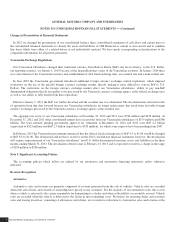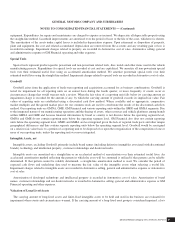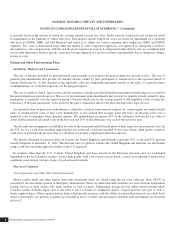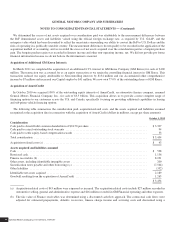General Motors 2012 Annual Report Download - page 88
Download and view the complete annual report
Please find page 88 of the 2012 General Motors annual report below. You can navigate through the pages in the report by either clicking on the pages listed below, or by using the keyword search tool below to find specific information within the annual report.
GENERAL MOTORS COMPANY AND SUBSIDIARIES
NOTES TO CONSOLIDATED FINANCIAL STATEMENTS — (Continued)
programs provide employees reduced wages and continued coverage under certain employee benefit programs depending on the
employee’s classification as well as the number of years of service that the employee has accrued. A similar tiered benefit is provided
to Canadian Auto Workers Union (CAW) employees. We recognize a liability for these SUB/TSP benefits over the expected service
period of employees, based on our best estimate of the probable liability at the measurement date.
Stock Incentive Plans
We measure and record compensation expense for all share-based payment awards based on the award’s estimated fair value which
is the fair value of our common stock on the date of grant, or for restricted stock units (RSUs) granted prior to our public offering, the
fair value of our common stock as of the date of the public offering. We record compensation cost for the awards on a straight-line
basis over the entire vesting period, or for retirement eligible employees over the requisite service period.
Salary stock awards granted are fully vested and nonforfeitable upon grant; therefore, compensation cost is recorded on the date of grant.
The liability for stock incentive plan awards settled in cash is remeasured to fair value at the end of each reporting period.
Policy, Product Warranty and Recall Campaigns
The estimated costs related to policy and product warranties are accrued at the time products are sold and are charged to
Automotive cost of sales. These estimates are established using historical information on the nature, frequency and average cost of
claims of each vehicle line or each model year of the vehicle line and assumptions about future activity and events. Revisions are
made when necessary, based on changes in these factors. Trends of claims are actively studied and actions are taken to improve
vehicle quality and minimize claims.
The estimated costs related to product recalls are based on a formal campaign soliciting return of that product are accrued when
they are deemed to be probable and can be reasonably estimated.
Income Taxes
The liability method is used in accounting for income taxes. Deferred tax assets and liabilities are recorded for temporary
differences between the tax basis of assets and liabilities and their reported amounts in the consolidated financial statements, using the
statutory tax rates in effect for the year in which the differences are expected to reverse. The effect on deferred tax assets and
liabilities of a change in tax rates is recorded in the results of operations in the period that includes the enactment date under the law.
Deferred income tax assets are evaluated quarterly to determine if valuation allowances are required or should be adjusted. We establish
valuation allowances for deferred tax assets based on a more likely than not standard. The ability to realize deferred tax assets depends on the
ability to generate sufficient taxable income within the carryback or carryforward periods provided for in the tax law for each applicable tax
jurisdiction. We consider the following possible sources of taxable income when assessing the realization of deferred tax assets:
• Future reversals of existing taxable temporary differences;
• Future taxable income exclusive of reversing temporary differences and carryforwards;
• Taxable income in prior carryback years; and
• Tax-planning strategies.
The assessment regarding whether a valuation allowance is required or should be adjusted also considers all available positive and
negative evidence factors, including but not limited to:
• Nature, frequency, and severity of recent losses;
• Duration of statutory carryforward periods;
General Motors Company 2012 ANNUAL REPORT 85
























